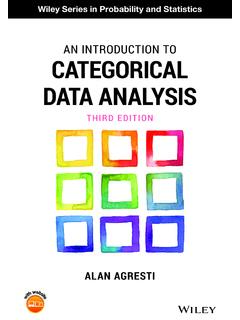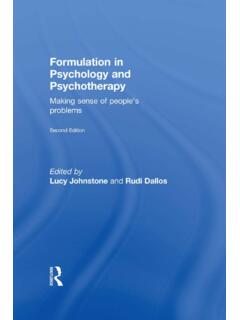Transcription of Formulation in Psychology and Psychotherapy
1 Formulation in Psychology and PsychotherapyThe fi rst edition of Formulation in Psychology and Psychotherapy caught the wave of growing interest in Formulation in a clinical context. This completely updated and revised edition summarises recent practice, research, developments and debates while retaining the features that made the fi rst a leading text in the fi eld. It contains new chapters on personal construct Formulation , Formulation in health settings and the innovative practice of using Formulation in teams. The book sees Formulation as a dynamic process which explores personal meaning collaboratively and refl ectively, taking account of relational and social contexts. Two case studies, one adult and one child, illustrate the use of Formulation from the perspectives of expert clinicians from six different theoretical positions.
2 The book encourages the reader to take a constructively critical perspective on the many philosophical, professional and ethical debates raised by the process of formulating people s problems. Among the issues explored are: the social and political context of Formulation ; Formulation in relation to psychiatric diagnosis; the limitations of Formulation ; controversies and debates about readable and comprehensive guide to the fi eld provides a clear, up-to-date and thought-provoking overview of Formulation from a number of perspectives, essential for clinicians working in all areas of mental health and social care, Psychology , therapy and Johnstone is a consultant clinical psychologist and a former Programme Director of the Bristol Clinical Psychology Doctorate. She has worked in adult mental health settings for many Dallos is the Research Director on the Clinical Psychology training programme at the University of Plymouth.
3 He also works as a clinical psychologist specialising in work with adolescents and their page intentionally left blankFormulation in Psychology and PsychotherapyMaking sense of people s problemsSecond editionEdited by Lucy Johnstone and Rudi DallosFirst published 2014by Routledge27 Church Road, Hove, East Sussex BN3 2FA Simultaneously published in the USA and Canadaby Routledge711 Third Avenue, New York, NY 10017 Routledge is an imprint of the Taylor & Francis Group, an informa business 2014 Lucy Johnstone and Rudi DallosThe right of the editors to be identified as the authors of the editorial material, and of the authors for their individual chapters, has been asserted in accordance with sections 77 and 78 of the Copyright, Designs and Patents Act rights reserved. No part of this book may be reprinted or reproduced or utilised in any form or by any electronic, mechanical, or other means, now known or hereafter invented, including photocopying and recording, or in any information storage or retrieval system, without permission in writing from the notice: Product or corporate names may be trademarks or registered trademarks, and are used only for identification and explanation without intent to Library Cataloguing in Publication DataA catalogue record for this book is available from the British LibraryLibrary of Congress Cataloging in Publication DataFormulation in Psychology and Psychotherapy : understanding people s problems / edited by Lucy Johnstone and Rudi Dallos.
4 -- Second cmIncludes bibliographical references and Psychology --Methodology. 2. Psychotherapy --Methodology. I. Johnstone, Lucy, editor of compilation. II. Dallos, Rudi, 1948- editor of compilation. 14--dc232012048131 ISBN: 978-0-415-68230-5 (hbk)ISBN: 978-0-415-68231-2 (pbk)ISBN: 978-0-203-38057-4 (ebk)Typeset in Garamond 3by Saxon Graphics Ltd, DerbyThis book is dedicated to the memory of the Bristol Clinical Psychology Doctorate 2001 2010 and the staff, trainees and supervisors who contributed to its critical and reflective page intentionally left blankContentsList of fi gures and tables xvList of contributors xviiPreface to the second edition xx1 Introduction to Formulation 1 LUCY JOHNSTONE AND RUDI DALLOSF ormulation in Psychology and Psychotherapy 1 What do we mean by Formulation ? 4 Team Formulation 5 Differences and common factors in Formulation 5 What is the purpose of a Formulation ?
5 6 Psychodynamic 7 Cognitive-behavioural 7 Systemic 7 Integrative 8 How did the concept of Formulation arise? 9 Psychodynamic approaches 9 Cognitive-behavioural approaches 10 Systemic approaches 11 Other therapeutic traditions 12 Best practice in Formulation 12 Conclusion 13 Jack 13 Janet 15 References 16viii Contents2 Case Formulation in cognitive behavioural therapy: a principle-driven approach 18 ROBERT DUDLEY AND WILLEM KUYKENA principled approach to CBT case conceptualisation 18 Jack 20 Principle 1: levels of conceptualisation 20 Presenting issues 20 Perpetuating factors 23 Precipitating factors 27 Predisposing factors: quantity of events 30 Predisposing factors: quality of events 30 Principle 2: collaborative empiricism 33 Principle 3: include client strengths and conceptualise resilience 34 Janet 37 Levels of conceptualisation 37 Collaborative empiricism 38 Strengths and resilience 38 Refl ections 40 Conclusions 41 Key characteristics of CBT Formulation 42 Acknowledgements 42 References 42 3 Psychodynamic Formulation : looking beneath the surface 45 ROB LEIPER What is a psychodynamic approach?
6 45 Core features of a psychodynamic approach 46 The dynamic perspective 46 The developmental perspective 49 The structural perspective 52 The adaptive perspective 54 Jack: a psychodynamic Formulation 57A prince betrayed and disinherited 57 Refl ection on the Formulation 59 Towards intervention 59 Janet: a psychodynamic Formulation 61 A girl unheld 61 Refl ections 62 Key characteristics of a psychodynamic Formulation 64 References 65 Contents ix4 Systemic Formulation : mapping the family dance 67 RUDI DALLOS AND JACQUI STEDMONThe systemic approach 67 Symptoms and family processes 67 Core systemic concepts 68 Formulation in systemic practice 69 Exploration of the problem 70 Progressive hypothesising 71 Family therapy and social constructionism 72 Use of self-refl ective Formulation 73 A proposed model of systemic Formulation 73 Jack: a systemic Formulation 74 Deconstructing the problem 74 Problem-maintaining patterns and feedback loops 76 Beliefs and explanations 77 Transitions, emotions, attachments 79 Contextual factors 82 Summary 83 Synthesis: a systemic Formulation for Jack 83 Janet: a systemic Formulation 85 Deconstructing the problems 85 Problem-maintaining patterns and feedback loops 87 Beliefs and explanations 87 Transitions, emotions and attachments 88 Contextual factors 89 Synthesis: a systemic Formulation for Janet 90 First Formulation 90 Second Formulation 91 Comments 91 The politics of Formulation 93 Key characteristics of a systemic Formulation 94 References 945 Formulation and narrative therapy.
7 Telling a different story 96 DAVID HARPER AND DAVE SPELLMANF ormulation and narrative therapy 96 Theoretical infl uences on the development of narrative therapy 96 Relating these ideas to social constructionism 97 The assumptions of narrative therapy 98x ContentsStretching the notion of Formulation 100 Preamble to the case examples 101 Jack: a narrative therapy Formulation 102 Externalising conversations: naming the problem 102 Tracing the history of the problem 104 Exploring the effects of the problem 105 Situating the problem in context: deconstruction 105 Unique outcomes 106 Tracing the history and meaning of the unique outcomes and naming an alternative story 107 Re-membering conversations 108 Therapeutic documents 108 Expanding the conversation: leagues and teams 109 Outsider-witness groups and defi nitional ceremonies 110 To formulate or not to formulate?
8 110 Janet: a narrative therapy Formulation 112 The context of the referral 112 Collaboration 112 Externalisation 114 Key characteristics of a narrative therapy approach to Formulation 116 Acknowledgements 116 Notes 117 References 1176 Reformulating the impact of social inequalities: power and social justice 121 LYNN MCCLELLANDWhat is a social inequalities approach? 121 What are social inequalities? 122 Social inequalities and mental health 122 Critical evaluation of the evidence base 124 Power and inequality 126 Refl ecting real-life diversity and recognising difference 127 Making Jack more visible: critical Formulation 128 Collaborative Formulation : situating Jack s experiences 129 Dialogue: A few lines about a world of trouble 129 Critical refl ections on the discussion 131 Masculinity as problematic 131 Formulating power 132 Social justice and empowerment potentials 133 Contents xiMaking Janet more visible.
9 Critical Formulation 134 Femininity as problematic 134 Formulating power 135 Restoring meaning through making socio-cultural context visible 136 Refl exive practice 138 Key characteristics of Formulation from a social inequalities perspective 139 Acknowledgements 139 References 1397 Formulation in personal and relational construct Psychology : seeing the world through clients eyes 145 DAVID WINTER AND HARRY PROCTERP ersonal Construct Psychology 145 Personal construct Formulation 147 Diagnostic constructs 148 Covert construing 148 Structure of construing 149 Strategies of construing 149 Control 150 Emotions 150 Dependency 151 Content of construing 151 Developments in the personal construct view of disorder 151 Relational extension of PCP 152 Relationality and levels of interpersonal construing 153 Personal construct assessment methods 153 Interviews 153 Self-characterisation 154 Repertory grid technique 154 Qualitative grids and the bowtie 155 Tracing of construct implications 155 Jack and Janet 155 Jack 156 Validational history 156 Jack s constructs 156 Structure and process of construing 157 Constructs of transition 157 Towards intervention 158xii ContentsJanet 161 Monadic
10 Construing 161 Dyadic construing 164 Triadic construing 167 Discussion 167 Key characteristics of Personal Construct Psychology Formulation 168 Acknowledgements 169 References 1698 Integrative Formulation in theory 173 RUDI DALLOS, JACQUI STEDMON AND LUCY JOHNSTONEI ntegrative formulations 173 Eclecticism 175 Conceptual synthesis 176 Some refl ections: implicit integration in practice 178 Weerasekera s framework 179 Jack: Formulation using Weerasekera s framework 180 Assessment 180 Advantages and limitations of the Weerasekera framework and the 4 Ps 181 Integrative formulating: towards some principles in practice 184 Integration through formulating in the therapeutic relationship 186 Formulating as an active process 186 Personal meaning as the central integrating factor in Formulation 186 Personal development and integration 187 Checklist of best practice integrative Formulation 187 Summary 187 References 1889 Integrative Formulation in practice.









